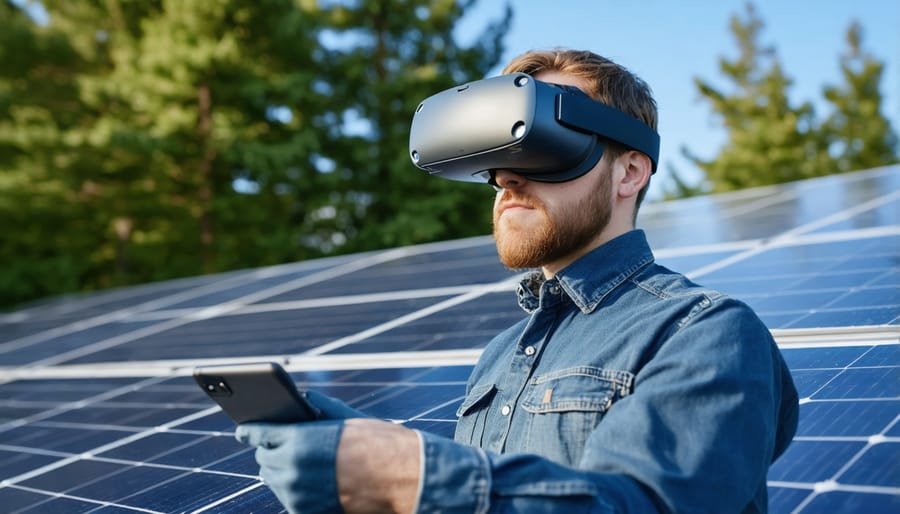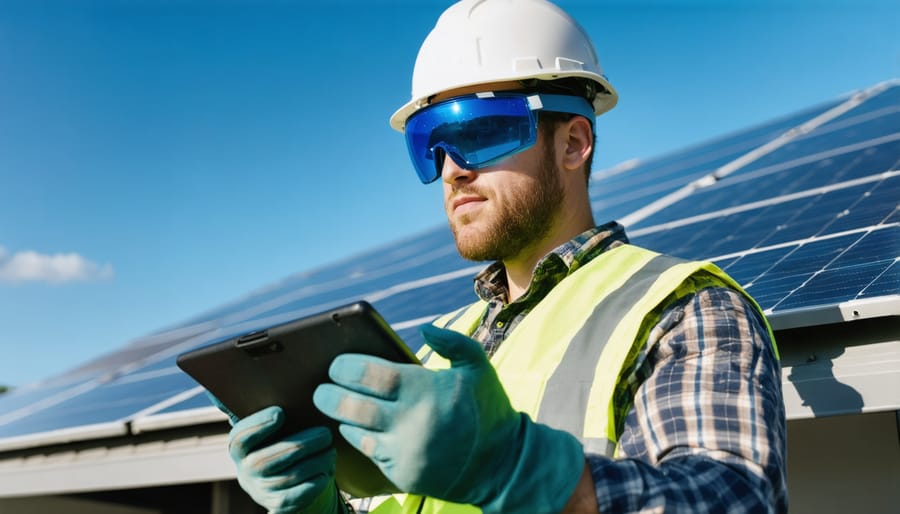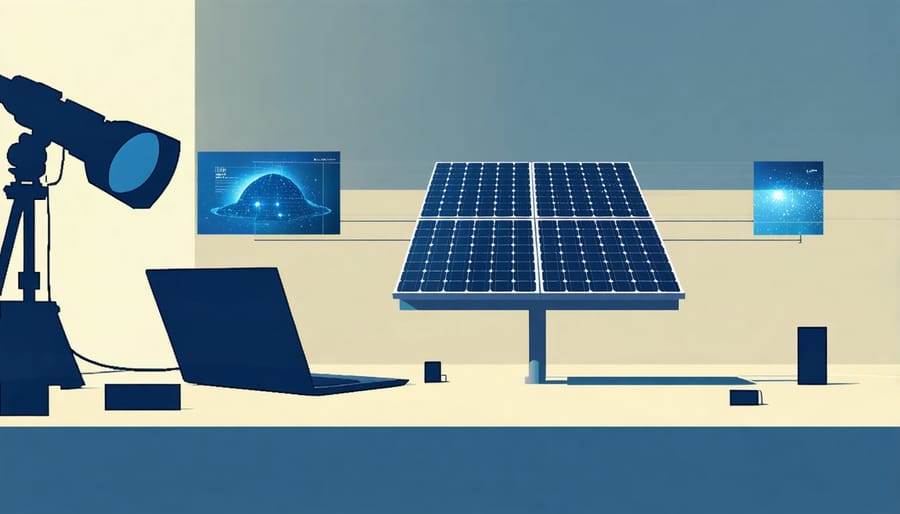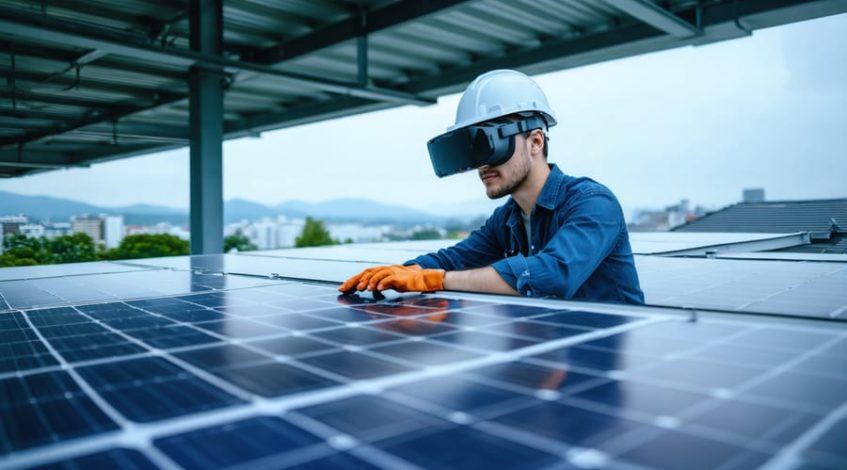Mixed reality technologies are revolutionizing industrial operations through unprecedented levels of smart technology integration, creating a paradigm shift in how businesses visualize, interact with, and optimize their processes. By merging digital information with physical environments in real-time, mixed reality solutions enable facility managers and technical teams to access critical data, collaborate remotely, and make informed decisions with remarkable precision. This transformative technology has demonstrated up to 40% improvement in maintenance efficiency and a 30% reduction in training time across various industrial applications.
The convergence of augmented reality (AR), virtual reality (VR), and Internet of Things (IoT) sensors is enabling organizations to create digital twins of their facilities, monitor equipment performance in real-time, and provide immersive training experiences that were previously impossible. As implementation costs decrease and hardware capabilities advance, mixed reality is becoming an essential tool for organizations seeking to maintain competitive advantage in an increasingly digital industrial landscape.
Leading manufacturers and facility operators are already leveraging these technologies to streamline operations, enhance worker safety, and drive operational excellence through data-driven decision making.
How Mixed Reality is Revolutionizing Solar Operations
Key Mixed Reality Tools in Solar Management
The solar industry has embraced several cutting-edge mixed reality tools that are revolutionizing installation, maintenance, and management processes. Microsoft’s HoloLens 2 stands out as a leading enterprise-grade headset, enabling technicians to view 3D solar panel layouts superimposed on actual rooftops and access real-time performance data while keeping their hands free for work.
Smart glasses, such as the RealWear HMT-1, offer ruggedized solutions specifically designed for field operations. These devices provide crucial information like installation guides, safety protocols, and remote expert assistance directly in the technician’s field of view, significantly reducing installation time and potential errors.
Mobile applications integrated with AR capabilities have become essential tools for solar professionals. Apps like Solar AR Viewer and Solmetric SunEye utilize smartphone cameras to analyze roof conditions, simulate shadow patterns, and calculate optimal panel placement. These applications make preliminary assessments more accurate and help streamline the design process.
For monitoring and maintenance, mixed reality platforms like TeamViewer Frontline combine AR visualization with IoT sensor data, allowing technicians to instantly access panel performance metrics, thermal imaging data, and maintenance histories by simply looking at specific components.
Project managers are increasingly utilizing VR solutions for team training and client presentations. Platforms such as Solar VR Training simulate complex installation scenarios in safe, controlled environments, while visualization tools help clients understand proposed solar layouts and expected energy production through immersive 3D experiences.
These tools not only enhance operational efficiency but also improve safety standards and customer satisfaction by enabling more precise installations and better-informed decision-making processes.

Real-time Monitoring and Visualization
Mixed reality technology has revolutionized real-time system monitoring and data visualization in commercial solar installations, offering unprecedented insights into system performance and maintenance needs. Through MR interfaces, facility managers and technicians can now observe live data overlays directly in their field of vision, enabling immediate identification of performance issues and optimization opportunities.
These advanced visualization capabilities allow users to see real-time power generation metrics, temperature readings, and equipment status indicators superimposed onto physical solar arrays. Maintenance teams can instantly access historical performance data, weather impact analysis, and predictive maintenance alerts while walking through their facilities, significantly reducing response times and improving operational efficiency.
The technology integrates seamlessly with existing building management systems and IoT sensors, creating a comprehensive monitoring environment that transforms complex data into intuitive visual representations. Facility managers can interact with 3D models of their solar installations, manipulate system parameters, and analyze performance metrics through gesture-based controls and voice commands.
For large-scale solar installations, MR-powered monitoring solutions offer multi-site visualization capabilities, enabling operators to simultaneously monitor and compare performance across different locations. The system can highlight anomalies, suggest optimization strategies, and provide interactive troubleshooting guidance, all within an immersive 3D environment.
This enhanced visualization approach has demonstrated significant improvements in maintenance efficiency, with organizations reporting up to 40% reduction in diagnostic time and a 25% increase in system uptime. The ability to quickly identify and address performance issues has proven particularly valuable during critical maintenance periods and severe weather events.
Practical Applications in Commercial Solar

Installation and Maintenance Enhancement
Mixed reality technologies have revolutionized installation and maintenance procedures across industrial sectors, offering unprecedented accuracy and efficiency improvements. Technicians equipped with MR devices can now visualize complex installation procedures through step-by-step holographic guides, reducing errors and installation time by up to 40%.
During installation, MR overlays provide precise component placement instructions, ensuring perfect alignment and positioning of equipment. Technicians can see exact measurements, specifications, and assembly sequences in real-time, while their hands remain free to perform the necessary tasks. This capability has proven particularly valuable in complex industrial environments where precision is crucial.
Maintenance operations have similarly been transformed through MR applications. Technicians can access real-time diagnostic data, maintenance histories, and repair instructions overlaid directly onto the equipment they’re servicing. This immediate access to critical information has reduced diagnostic time by an average of 60% while improving first-time fix rates.
Remote expert collaboration has become seamless through MR technology, allowing experienced technicians to guide on-site workers through complex procedures without physical presence. This capability has significantly reduced travel costs and downtime, with some organizations reporting maintenance cost savings of up to 30%.
MR-enhanced maintenance systems also facilitate predictive maintenance by visualizing performance data and potential failure points before they become critical issues. This proactive approach has helped facilities reduce unexpected downtime by up to 50% while extending equipment lifespan.
Remote Troubleshooting and Support
Mixed reality technologies have revolutionized remote support capabilities, enabling experts to provide real-time assistance and diagnostics from anywhere in the world. Through MR headsets and collaborative platforms, technicians on-site can share their exact field of view with remote specialists, who can then overlay instructions, annotations, and 3D models directly onto the technician’s visual field.
This capability has proven particularly valuable in complex industrial settings, where equipment downtime can result in significant financial losses. Remote experts can guide local personnel through intricate repair procedures, reducing resolution time by up to 40% and minimizing the need for costly on-site visits. The technology allows for immediate access to specialized expertise, particularly beneficial for facilities in remote locations or during emergency situations.
Companies implementing MR-based remote support report substantial cost savings, with some organizations reducing their travel expenses by up to 70% while improving first-time fix rates by 30%. The technology also enables detailed documentation of troubleshooting procedures, creating valuable reference materials for future maintenance needs.
Security features built into modern MR platforms ensure that sensitive technical information remains protected during remote sessions, while integration with existing workflow management systems streamlines the support process. This combination of efficiency, cost-effectiveness, and security makes MR-based remote support an increasingly essential tool for modern industrial operations.

ROI and Business Benefits
Cost Savings and Efficiency Gains
Mixed reality technologies are driving significant cost reductions across solar facility operations, with documented savings ranging from 25-40% in maintenance expenses and up to 60% in training costs. By enabling remote expertise and virtual collaboration, organizations can substantially reduce travel expenses and downtime associated with traditional maintenance approaches.
The implementation of MR solutions helps facilities optimize system performance while minimizing labor costs. Real-time data visualization and predictive maintenance capabilities allow teams to address potential issues before they escalate into costly repairs, resulting in an average 30% reduction in unexpected downtime.
Training efficiency has shown remarkable improvement, with new technicians reaching proficiency up to 70% faster through immersive learning experiences. This accelerated learning curve translates to reduced training budgets and faster deployment of skilled personnel. Additionally, virtual design and planning capabilities reduce pre-installation costs by approximately 15-20% through better resource allocation and reduced physical prototyping needs.
The return on investment for mixed reality implementation typically occurs within 12-18 months, with ongoing operational savings continuing to accumulate through improved workflow efficiency and reduced error rates.
Training and Skill Development
Mixed reality technologies are revolutionizing workforce training and skill development across industries. By creating immersive learning environments, MR enables workers to practice complex procedures and gain hands-on experience without risk to equipment or personnel. Technicians can receive real-time guidance through MR headsets, with expert supervisors remotely demonstrating proper techniques and providing immediate feedback.
Organizations implementing MR training programs report significant improvements in knowledge retention and skill acquisition. Studies show that MR-based training can reduce learning time by up to 60% while improving accuracy rates by 40% compared to traditional methods. The technology allows for standardized training delivery across multiple locations, ensuring consistency in skill development and operational procedures.
MR training simulations can recreate various scenarios, from routine maintenance to emergency responses, allowing workers to build muscle memory and confidence before handling actual equipment. The ability to visualize complex systems in 3D space helps technicians better understand system components and their interactions. Additionally, MR platforms can track trainee progress, provide performance metrics, and identify areas needing improvement, enabling personalized learning paths and more effective skill development programs.
Mixed reality technologies are revolutionizing solar technology management, offering unprecedented levels of efficiency, accuracy, and cost-effectiveness. The integration of MR solutions has demonstrated significant improvements in installation processes, maintenance procedures, and operational oversight, leading to reduced downtime and enhanced system performance. Industry adoption continues to accelerate as businesses recognize the tangible benefits of implementing these innovative tools.
Looking ahead, the convergence of mixed reality with artificial intelligence and IoT capabilities promises even more sophisticated applications. We can expect to see advanced predictive maintenance systems, automated troubleshooting protocols, and more intuitive training platforms. As hardware costs decrease and software capabilities expand, MR technology will become increasingly accessible to organizations of all sizes, fundamentally transforming how we manage and maintain solar energy infrastructure. This technological evolution positions mixed reality as a cornerstone of future-ready solar energy management systems.

